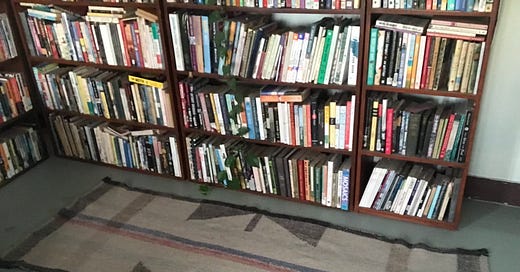A few days ago, Marv had a small accident on a corner of the rug I keep near my bed. Unlike some of my other carpets, which are the more familiar knotted type, I wasn’t worried about this one; I knew it wouldn’t be that hard to clean. Simply tossing it in the washing machine with some wool detergent is enough to easily get it as good as new.
It got me thinking about these lesser known Nepali made-products and how long it took me to discover them. Some—woodwork, pottery, and so on—are well known.
But there are also less familiar but equally beautiful ones.
I first encountered these woolen rugs when I bought one from an elderly man outside the Le Sherpa farmer’s market years ago—that’s it in the picture above, which now lives in front of my bookshelves. I love its colors and it is very pleasant on bare feet. Still, though, I wasn’t looking to get another, when, in the spring of 2021, a few days before the second lockdown, and around the same time I moved to this flat, I bumped into the same man again, toting a pile of rugs outside a restaurant on the complete other side of town, in Lalitpur.
Like I said, I didn’t think I needed another rug, but he really looked like he needed a sale, and we all knew another lockdown was looming. Impulse purchases don’t always work out, but I looked though his stack and picked one; different colors: muted, earthy, blue-greens and tans, a little shorter and wider than my first one.
Once I was settled in my new house with a new bed, it turned out that the rug fit the space alongside it perfectly. It’s a little uneven on one end, a little wonky, but as they say that’s a feature and not a bug, and it was an unexpected buy that has brought me so much joy ever since.
And they are just great quality; somehow I had thought they were made of yak wool, but a little bit of online research has turned up that they are actually made of sheep or goat’s wool and known as radi, traditional rugs or blankets from the hilly area of Helambu, a bit north of Kathmandu.
I see them a little more often these days—there are more vendors carrying them over shoulders or displaying them on roadsides, and of late I occasionally even spot some for sale at seriously inflated prices in higher-end craft stores. I’m glad they’re getting wider exposure and I hope the margin is getting passed on, but still, whenever I buy them as gifts, as I have more than once since, I try to always seek out one of the old men from Helambu. True, you can’t predict when you’ll encounter one, so it’s hard to plan for, but if I can I prefer my money to go as as close to the source as possible.
They’re beautiful and durable and naturally made, and if your cat should happen to soil one when he’s not feeling the best due to his ongoing digestive issues, well—after a wash it’ll be even better and softer. Honestly, these rugs will probably outlive us all. Just one of the many reasons I love things that are made of natural fabrics, and woven just as they have been for generations.



